标签:副本 作用 tick 同步代码块 show 默认 content isp hide
线程生命周期

线程命名

1 class MyThread implements Runnable{ 2 @Override 3 public void run() { 4 System.out.println(Thread.currentThread().getName()); 5 } 6 } 7 8 public class TestDemo { 9 public static void main(String[] args) throws Exception{ 10 MyThread mt = new MyThread(); 11 new Thread(mt,"自己的线程").start(); 12 mt.run(); 13 } 14 }

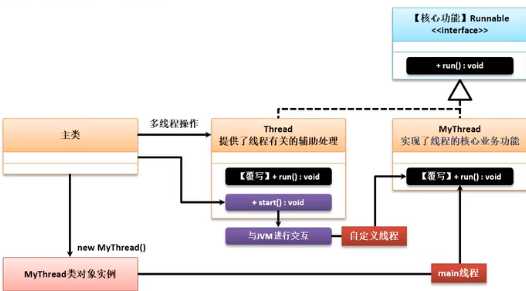

线程休眠
 View Code
View Code 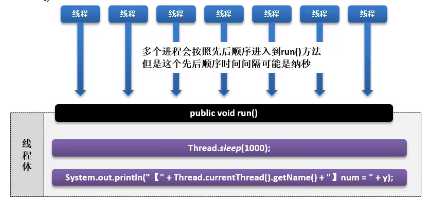
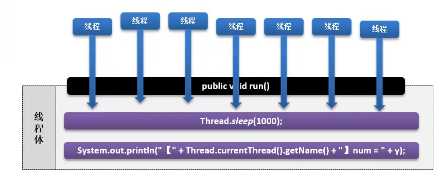
线程中断


1 public class Sleep_Demo { 2 public static void main(String[] args) throws Exception{ 3 Thread thread = new Thread(()->{ 4 try { 5 System.out.println("["+Thread.currentThread().getName()+"]准备进入休眠状态,预计时间10秒..."); 6 Thread.sleep(10000); 7 System.out.println("["+Thread.currentThread().getName()+"]休眠状态正常结束..."); 8 } catch (InterruptedException e) { 9 System.out.println("["+Thread.currentThread().getName()+"]休眠产生异常,无法正常完成休眠..."); 10 } 11 },"休眠线程"); 12 thread.start(); 13 System.out.println("[中断状态]" + thread.isInterrupted()); 14 Thread.sleep(2000); 15 thread.interrupt(); 16 } 17 }

线程强制执行

1 public class Sleep_Demo { 2 public static void main(String[] args) throws Exception{ 3 Thread mainThread = Thread.currentThread(); 4 Thread joinThread = new Thread(()->{ 5 for(int x = 0 ; x < 1000 ; x ++ ){ 6 try { 7 Thread.sleep(1000); 8 if(x >= 10) { 9 mainThread.join(); // 子线程交出全部资源给主线程 10 } 11 System.out.println("["+Thread.currentThread().getName()+"]子线程执行,x = " + x); 12 }catch(InterruptedException e) { 13 e.printStackTrace(); 14 } 15 } 16 },"工作线程"); 17 joinThread.start(); // 启动子线程 18 for(int x = 0 ; x < 1000 ; x ++ ) { 19 Thread.sleep(1000); 20 System.out.println("[" + Thread.currentThread().getName() + "]线程执行,x = " + x); 21 } 22 } 23 }
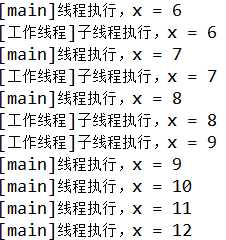
线程礼让

1 public class Sleep_Demo { 2 public static void main(String[] args) throws Exception{ 3 Thread mainThread = Thread.currentThread(); 4 Thread joinThread = new Thread(()->{ 5 for(int x = 0 ; x < 1000 ; x ++ ){ 6 try { 7 if(x % 2 == 0) { 8 Thread.yield(); 9 System.out.println("[YIELD]线程礼让执行"); 10 } 11 Thread.sleep(1000); 12 System.out.println("["+Thread.currentThread().getName()+"]子线程执行,x = " + x); 13 }catch(InterruptedException e) { 14 e.printStackTrace(); 15 } 16 } 17 },"工作线程"); 18 joinThread.start(); // 启动子线程 19 for(int x = 0 ; x < 1000 ; x ++ ) { 20 Thread.sleep(1000); 21 System.out.println("[" + Thread.currentThread().getName() + "]线程执行,x = " + x); 22 } 23 } 24 }
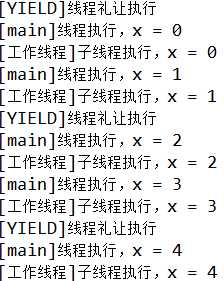
线程优先级

1 public class Sleep_Demo { 2 public static void main(String[] args) throws Exception{ 3 // 定义线程数组 4 Thread threads [] = new Thread[3]; 5 for(int x = 0 ; x < threads.length ; x ++ ) { 6 threads[x] = new Thread(()->{ 7 while(true) { 8 try { 9 Thread.sleep(1000); 10 System.out.println("["+Thread.currentThread().getName()+"]线程执行,线程优先级"+Thread.currentThread().getPriority()); 11 }catch(InterruptedException e){ 12 e.printStackTrace(); 13 } 14 } 15 }); 16 } 17 // 设置线程优先级 18 threads[0].setPriority(Thread.MIN_PRIORITY); 19 threads[2].setPriority(Thread.MIN_PRIORITY); 20 threads[1].setPriority(Thread.MAX_PRIORITY); 21 // 启动线程 22 for(int x = 0 ; x < threads.length; x ++) { 23 threads[x].start(); 24 } 25 } 26 }
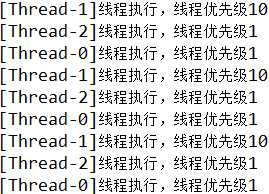
同步与死锁
未加锁的程序:

1 public class Synchronize_Demo { 2 public static int ticket = 5; 3 public static void main(String[] args) throws Exception { 4 Runnable body = () -> { 5 while(true) { 6 if(ticket > 0) { 7 try { 8 Thread.sleep(1000); 9 }catch(InterruptedException e) { 10 e.printStackTrace(); 11 } 12 System.out.println("["+Thread.currentThread().getName()+"]售票,当前剩余票数:"+ (--ticket)); 13 }else { 14 break; 15 } 16 } 17 }; 18 for(int x = 0 ; x <5 ; x ++) { 19 new Thread(body,"票贩子-" + x).start(); 20 } 21 } 22 }
加锁的程序(同步代码块):

1 public class Synchronize_Demo { 2 public static int ticket = 5; 3 public static void main(String[] args) throws Exception { 4 Synchronize_Demo SynDemo = new Synchronize_Demo(); 5 Runnable body = () -> { 6 while(true) { 7 synchronized(SynDemo) { 8 if(ticket > 0) { 9 try { 10 Thread.sleep(1000); 11 }catch(InterruptedException e) { 12 e.printStackTrace(); 13 } 14 System.out.println("["+Thread.currentThread().getName()+"]售票,当前剩余票数:"+ (--ticket)); 15 }else { 16 break; 17 } 18 } 19 } 20 }; 21 for(int x = 0 ; x <5 ; x ++) { 22 new Thread(body,"票贩子-" + x).start(); 23 } 24 } 25 }
或(同步方法):

1 public class Synchronize_Demo { 2 public static int ticket = 5; 3 public static void main(String[] args) throws Exception { 4 Synchronize_Demo SynDemo = new Synchronize_Demo(); 5 Runnable body = () -> { 6 while(sale()) {} 7 }; 8 for(int x = 0 ; x <5 ; x ++) { 9 new Thread(body,"票贩子-" + x).start(); 10 } 11 } 12 13 public static synchronized boolean sale() { 14 if(ticket > 0) { 15 try { 16 Thread.sleep(1000); 17 }catch(InterruptedException e) { 18 e.printStackTrace(); 19 } 20 System.out.println("["+Thread.currentThread().getName()+"]售票,当前剩余票数:"+ (--ticket)); 21 return true; 22 }else { 23 return false; 24 } 25 } 26 }
死锁:

1 class Book{} 2 class Paint{} 3 4 public class DeadLock_Demo { 5 public static void main(String[] args) throws Exception{ 6 Book book = new Book(); 7 Paint paint = new Paint(); 8 Thread threadA = new Thread(()->{ 9 synchronized(book) { 10 System.out.println("A对B说:你给我你的画,我再借你我的书"); 11 try { 12 Thread.sleep(1000); 13 14 synchronized(paint) { 15 Thread.sleep(1000); 16 System.out.println("A得到了B的画"); 17 } 18 } catch (InterruptedException e) { 19 e.printStackTrace(); 20 } 21 } 22 }); 23 Thread threadB = new Thread(()->{ 24 synchronized(paint) { 25 System.out.println("B对A说:你借我你的书,我再给你我的画"); 26 try { 27 Thread.sleep(1000); 28 synchronized(book) { 29 Thread.sleep(1000); 30 System.out.println("B得到了A的书"); 31 } 32 } catch (InterruptedException e) { 33 e.printStackTrace(); 34 } 35 } 36 }); 37 threadA.start(); 38 threadB.start(); 39 } 40 }
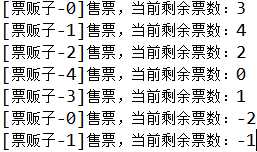
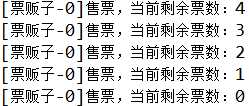
![]()

![]()
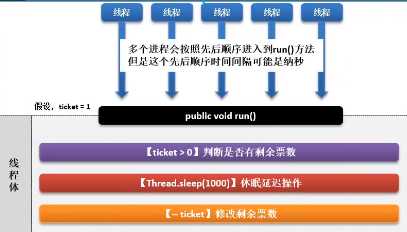
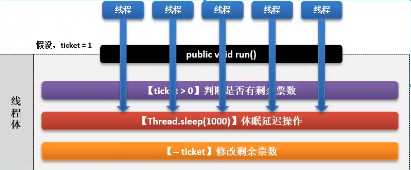

生产者与消费者
程序1

1 class Message{ 2 private String title; 3 private String content; 4 5 public void setTitle(String title) { 6 this.title = title; 7 } 8 9 public void setContent(String content) { 10 this.content = content; 11 } 12 13 public String getTitle() { 14 return title; 15 } 16 17 public String getContent() { 18 return content; 19 } 20 } 21 22 class ProducerThread implements Runnable{ 23 private Message message; 24 public ProducerThread(Message message) { 25 this.message = message; 26 } 27 @Override 28 public void run() { 29 for(int x = 0 ; x < 50 ; x ++ ) { 30 try { 31 if(x % 2 == 0) { 32 this.message.setTitle("李兴华"); 33 Thread.sleep(1000); 34 this.message.setContent("老师"); 35 }else { 36 this.message.setTitle("沐言"); 37 Thread.sleep(1000); 38 this.message.setContent("www.yootk.com"); 39 } 40 }catch(Exception e) {} 41 } 42 } 43 } 44 45 class ConsumerThread implements Runnable{ 46 private Message message; 47 public ConsumerThread(Message message) { 48 this.message = message; 49 } 50 @Override 51 public void run() { 52 for(int x = 0 ; x < 50 ; x ++ ) { 53 System.out.println("[消费者]title="+this.message.getTitle()+", content = " + this.message.getContent()); 54 try { 55 Thread.sleep(1000); 56 } catch (InterruptedException e) { 57 e.printStackTrace(); 58 } 59 } 60 } 61 }
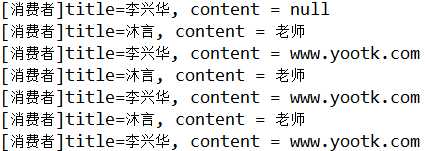


程序2(解决同步问题)

1 class Message{ 2 private String title; 3 private String content; 4 public synchronized void set(String title, String content) { 5 this.title = title; 6 try { 7 Thread.sleep(100); 8 } catch (InterruptedException e) { 9 e.printStackTrace(); 10 } 11 this.content = content; 12 } 13 public synchronized String get() { 14 try { 15 Thread.sleep(100); 16 } catch (InterruptedException e) { 17 e.printStackTrace(); 18 } 19 return "title = " + this.title + ", content = " + this.content; 20 } 21 } 22 23 class ProducerThread implements Runnable{ 24 private Message message; 25 public ProducerThread(Message message) { 26 this.message = message; 27 } 28 @Override 29 public void run() { 30 for(int x = 0 ; x < 50 ; x ++ ) { 31 if(x % 2 == 0) { 32 this.message.set("李兴华","老师"); 33 }else { 34 this.message.set("沐言","www.yootk.com"); 35 } 36 } 37 } 38 } 39 40 class ConsumerThread implements Runnable{ 41 private Message message; 42 public ConsumerThread(Message message) { 43 this.message = message; 44 } 45 @Override 46 public void run() { 47 for(int x = 0 ; x < 50 ; x ++ ) { 48 System.out.println("[消费者]"+this.message.get()); 49 } 50 } 51 } 52 53 public class PC_Demo { 54 public static void main(String[] args) throws Exception{ 55 Message message = new Message(); 56 new Thread(new ProducerThread(message)).start(); 57 new Thread(new ConsumerThread(message)).start(); 58 } 59 }
程序3(解决线程重复操作问题)

1 class Message{ 2 private String title; 3 private String content; 4 private boolean flag = true; 5 // flag = true:可以生产,但无法进行消费 6 // flag = false:可以消费,但无法进行生产 7 public synchronized void set(String title, String content) { 8 if(this.flag == false) { 9 try { 10 super.wait(); 11 } catch (InterruptedException e) { 12 e.printStackTrace(); 13 } 14 } 15 this.title = title; 16 try { 17 Thread.sleep(100); 18 } catch (InterruptedException e) { 19 e.printStackTrace(); 20 } 21 this.content = content; 22 this.flag = false; 23 super.notify(); 24 } 25 public synchronized String get() { 26 if(this.flag == true) { 27 try { 28 super.wait(); 29 } catch (InterruptedException e) { 30 e.printStackTrace(); 31 } 32 } 33 try { 34 Thread.sleep(100); 35 } catch (InterruptedException e) { 36 e.printStackTrace(); 37 } 38 this.flag = true; 39 super.notify(); 40 return "title = " + this.title + ", content = " + this.content; 41 } 42 } 43 44 class ProducerThread implements Runnable{ 45 private Message message; 46 public ProducerThread(Message message) { 47 this.message = message; 48 } 49 @Override 50 public void run() { 51 for(int x = 0 ; x < 50 ; x ++ ) { 52 if(x % 2 == 0) { 53 this.message.set("李兴华","老师"); 54 }else { 55 this.message.set("沐言","www.yootk.com"); 56 } 57 } 58 } 59 } 60 61 class ConsumerThread implements Runnable{ 62 private Message message; 63 public ConsumerThread(Message message) { 64 this.message = message; 65 } 66 @Override 67 public void run() { 68 for(int x = 0 ; x < 50 ; x ++ ) { 69 System.out.println("[消费者]"+this.message.get()); 70 } 71 } 72 } 73 74 public class PC_Demo { 75 public static void main(String[] args) throws Exception{ 76 Message message = new Message(); 77 new Thread(new ProducerThread(message)).start(); 78 new Thread(new ConsumerThread(message)).start(); 79 } 80 }
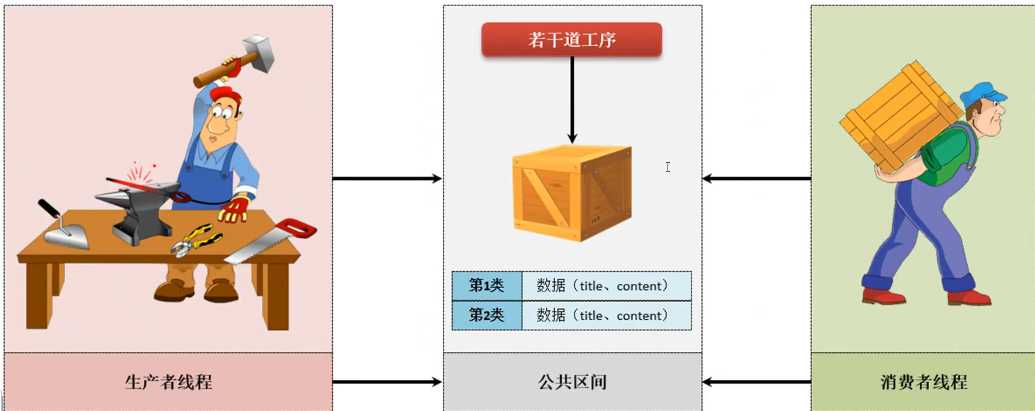
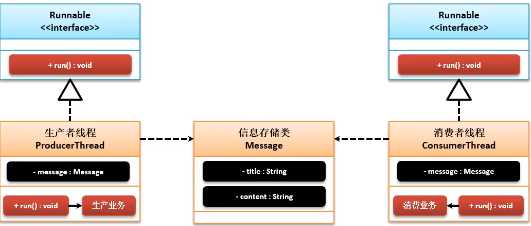
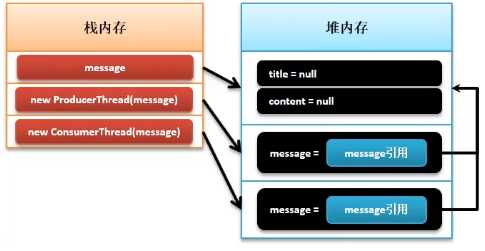

停止线程

1 class Thread_Stop implements Runnable{ 2 private boolean flag = false; //停止标志 3 @Override 4 public void run() { 5 for(int x = 0 ; x < 1000; x++) { 6 if(this.flag) { 7 break; 8 } 9 try { 10 Thread.sleep(100); 11 } catch (InterruptedException e) { 12 e.printStackTrace(); 13 } 14 System.out.println("[Message信息输出——" + x + "]沐言科技:www.yootk.com"); 15 } 16 } 17 public void stop() { 18 this.flag = true; 19 } 20 } 21 22 public class Daemon_Thread_Demo { 23 public static void main(String[] args) throws Exception{ 24 Thread_Stop message = new Thread_Stop(); 25 new Thread(message).start(); 26 Thread.sleep(500); 27 message.stop(); 28 } 29 }

守护线程

1 class Daemon_Thread implements Runnable{ 2 public Daemon_Thread() { 3 Thread daemonThread = new Thread(()->{ 4 for(int x = 0 ; x < Integer.MAX_VALUE ; x++) { 5 try { 6 Thread.sleep(100); 7 } catch (InterruptedException e) { 8 e.printStackTrace(); 9 } 10 System.out.println("[守护线程]编程训练营"); 11 } 12 }); 13 daemonThread.setDaemon(true); //设置为守护线程 14 daemonThread.start(); //守护线程启动 15 } 16 @Override 17 public void run() { 18 for(int x = 0 ; x < 10; x++) { 19 try { 20 Thread.sleep(100); 21 } catch (InterruptedException e) { 22 e.printStackTrace(); 23 } 24 System.out.println("[Message信息输出——" + x + "]沐言科技:www.yootk.com"); 25 } 26 } 27 } 28 29 public class Daemon_Thread_Demo { 30 public static void main(String[] args) throws Exception{ 31 Daemon_Thread message = new Daemon_Thread(); //实例化 32 new Thread(message).start(); //启动线程 33 } 34 }


volatile关键字
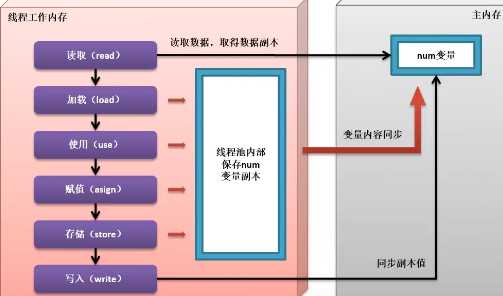
标签:副本 作用 tick 同步代码块 show 默认 content isp hide
原文地址:https://www.cnblogs.com/cxc1357/p/12433333.html